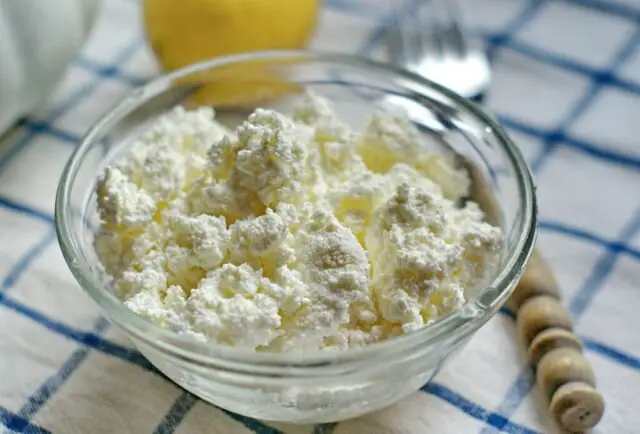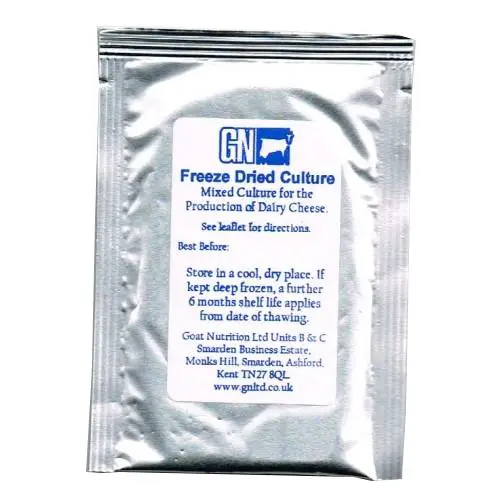Multiple Culture Options In A Recipe Use Your Package Preference
Some recipes may give you the option of using a few different cheese cultures. Most often the difference between these cultures is how they are packaged. For instance, our recipe for Edam Boule requires either 2 packets of the Mesophilic Starter Culture or 1/4 tsp. of a bulk mesophilic starter.
Each box of the Fresh Cheese Starter Culture, Mesophilic Starter Culture, and Thermophilic Starter Culture contains 8 packets of direct-set starter culture. You can use these on a per packet basis according to your recipe.
Other starter cultures come in a bulk packet and need to be measured out according to the recipe.
When a recipe gives you the option of using packets or bulk starter, which one you choose really just depends on your personal preference. Either will make delicious cheese!
Whats The Difference Between Cheese Culture & Cheese Mold
Cheese culture is primarily used to form the substance of the cheese inside by using good bacteria in the milk to flourish and leads to a more rich and developed flavor. Its a group of specific bacteria strains that are put together for making a specific cheese2. On the other hand, cheese mold helps form the outside of the cheese by adding bacteria to it which yields its unique texture and flavor. However, what cheese culture and cheese mold have in common is that they are both needed for the production of cheese and have good bacteria that help cheese develop its desired consistency.
Practical Use Of Starter Cultures
Cheesemakers generally use starters prepared in two main forms bulk starter or .
A section on bulk starter manufacture remains to be added. The article will discuss how the starter medium is sterilised, protected from contamination during cooling, the importance of head space control, how the starter vessel is inoculated aseptically and how -contamination can be avoided during incubation. Mention will also be made of systems for maintaining internal and external pH control and how common problems, as investigated by the author, can be solved.
Don’t Miss: What Sauce Is On Philly Cheese Steak Pizza
Homemade Cultured Cream Cheese Recipe
Thinking of learning how to make cultured cream cheese? Look no further! Here are some easy steps you can follow. Check them out below.
Mildly tart, perfectly salted, rich, and creamy, homemade cream cheese is delicious. When you take the time to make it yourself, you get a higher quality product. This is especially true if you go the fermentation route.
Not only do you get cream cheese with divine flavor and texture, but youll find that homemade cream cheese melts well, incorporates into sauces without breaking, and, most importantly, can be made to your liking.
The process of making cream cheese is simple yet very hands-on and ends with a wonderful feeling of accomplishment. Everything from seeing the curds separate from the whey to the satisfaction of scraping the finished product from the cheesecloth is a rewarding experience that results in a greater appreciation for cream cheese.
How Do Cheese Cultures Work

All cultures do the same basic work. Cheese cultures rapidly raise the acidity of milk by consuming the lactose present and converting it into lactic acid. This disables the already-present bacteria and helps the rennet to set the cheese.
Starter cultures also aid in development and preservation of the flavor and body of the cheese during cheese making and afterwards, in the aging process.
Recommended Reading: Does Babybel Cheese Need To Be Refrigerated
About The Milk & Cream
The milk I have chosen to use here is a local milk, but it is also one of the milks that has been pasteurized at higher than normal temperatures .
I have selected this to use here because this is a milk that is becoming more and more common on store shelves.
As you will see in the following photos this does form a very wonderful cream cheese with super flavor and texture.
The cream is ultra-pasteurized, as you can see by the label here. This is not a problem, though, because the cream portion is just for the butterfat.
The milk portion will provide the proteins for curd formation and should not be ultra-pasteurized.
Some of our customers have tried using just half and half for their cream cheese but this often tends to be ultra-pasteurized and will not form a good solid curd since all of the proteins have been damaged in the process. If you do find half and half that is not ultra-pasteurized, that will work for a very rich cheese since it has a higher fat content than the recipe I provide. This may also be more difficult to drain since the butterfat holds the moisture.
If you do have access to raw milk, you will find that you may need to use less culture and that your ripening times are less. Your curd may also be firmer and you may find that the cheese drains faster. If you pay attention to the ripening and draining cues in the following process, you should be well on track to making a great cheese from your raw milk.
Where To Buy Cheese Making Supplies
To make cream cheese at home, you’ll need supplies unique to cheese making, and as this traditional art has fallen from favor in modern kitchens, you’re unlikely to be able to purchase them locally unless you live in an area with a particularly vibrant food scene or very well-stocked health food stores.
For this reason, most home cheese makers purchase their supplies online from specialty shops .
Don’t Miss: Goat Cheese Charcuterie
Which Cheese Culture Do I Need
The cheese culture you will need will depend on the type of cheese you want to make. Our homemade cheese recipes take the guesswork out by listing out the type of culture you will need! However, if your recipe does not include the type of cheese culture you will need or if you are feeling spontaneous, then a general rule of thumb is to pay attention to the inoculation temperature during the ripening process. If the temperature is up to 90ºF, then we recommend to go with the mesophilic culture, but if the temperature is between 68-125° F then the thermophilic culture is preferred. Most common cheeses use the mesophilic culture to make your favorite cheeses like Mozzarella, Monterrey Jack, Colby, Cottage Cheese, and Cheddar. The texture of the cheese will also determine what type of culture is needed as well. For example, hard cheeses such as Swiss cheese, Parmesan and other hard cheeses typically call for a thermophilic starter culture because these types of cultures have a very high resistance to heat, making them a frequent ingredient in cheese that requires high temperatures5.
How To Make Cream Cheese
- 2 cups cream*
- 2 cups whole milk*
- Sea salt to taste
*Select raw dairy or regular pasteurized dairy. Avoid ultra-heat treated milk or cream, as it will yield inconsistent results.
Make sure you are using a glass container to hold your cream/milk. Gently stir in the starter culture.
Loosely cover and set it on your counter top to culture for 8 to 12 hours.
Youll know its done when it has set up and somewhat resembles yogurt.
Dump the thickened cream into the cheesecloth and allow the whey to drip out for at least 12 hours .
You might have to get a little creative with your drip set-up. I dont have any knobs on my cabinet doors, so I tie the ends of my improvised cheesecloth around a wooden spoon and allow it to drip into a pitcher.
Once it has reached the desired consistency, scrape it out of the cheesecloth and lightly salt it to taste. The salt is optional, but it will help it keep slightly longer. Store in an airtight container in your fridge it will get firmer as it chills.
I usually get 1 1/2 to 2 cups of cream cheese out of 1 quart of cream/milk. Yields will vary slightly.
Read Also: Does Babybel Cheese Need To Be Refrigerated
Sucrose Maltodextrins Lactic Bacteria Lactococcus Lactis Subsp
I have purchased a starter culture that contains 50u culture that can be used for 500l milk. Manufactured in a facility that processes products containing soy and dairy. In cream cheese, other soft cheeses and yogurts, it includes cultures belonging to a group called mesophilic cultures. Plus, it’s a healthy dip for fruit and. There are also several cultures that have a more broad usage. I’ve never tried using store bought as a culture though. Used in gouda, edam, sour cream and lactic butter. Mesophilic aromatic type b is another versatile cheese culture with a buttery flavor. Get culture provides cultures and other products and equipment required to produce cheese, yogurt and other fermented dairy products. Originally, starter cultures for the cheese industry were maintained by daily propagation, and later, they became available as frozen concentrates and dried or lyophilised preparations, produced on an mesophilic starter used for many cheese types. Stir in salt to taste. Well look no further than this quick guide to the different types of starter. Some of the soft cheese culture packs have small amounts of vegetable rennet in them.
What Cheeses Are Made With Cheese Culture
Most cheeses like Cheddar, Gouda, Mozzarella, Brie, and Camembert require a certain type of cheese culture in order to make them because they are aged. In rare instances, some soft, fresh cheeses like cream cheese or cottage cheese do not require any type of cheese culture because they are unaged. The most popular cheeses require one of two common types of cultures: mesophilic or thermophilic based on the temperature in which they work. Mesophilic culture is the most common culture of the two due to its broad usage and medium temperature range. If youre still unsure which type of cheese culture to use, feel free to follow a cheese recipe or use this article to guide you in the right direction!
Also Check: Does Babybel Cheese Need To Be Refrigerated
I Can Sum Up The Reason I Have A Milk Cow In One Word:
CREAM.
Ok, so there are more reasons than that, I suppose. But cream has a lot to do with it. Fresh cream sitting on the top of a gallon of raw milk is a beautiful thing, my friends.
And theres so much stuff you can do with it. Homemade butter, homemade cream cheese, whipped cream frosting, swirling it into your coffee. Good grief, how could someone NOT love cream?
If you use as much sour cream as we do , youll be happy to know its pretty darn easy to make. Its very similar to learning how to make buttermilk, but you use cream instead of milk, and a slightly different starter culture. Heres how to make sour cream at home:
Molds Used In Cheesemaking

Molds are responsible for giving some cheeses their specific flavor and texture. They are usually applied to the outside of the cheese where they form a crust.
- Penicillium Camembertiwhite mold spores are used for making Camembert and Brie cheeses and are essential in the ripening process of cheeses with white surface mold.
- Penicillium Roquefortimold spores are used for making Blue Cheese and are essential in the ripening process.
Ready to Learn More?
You May Like: Mac And Cheese Sour Cream No Milk
Homemade Sour Cream Notes:
- I use our raw cream, but pasteurized cream will work toojust avoid UHT cream if you can.
- If you are using raw cream, your end result might be a bit less thick than the sour cream from the store. But its still delicious and definitely usable.
- If you have access to raw cream, making sour cream can be as easy as letting raw cream sit out on the counter and sour.
- However, I prefer the flavor of sour cream that has been inoculated with a bit of starter culture. It allows me to have more control over the flavor.
How To Make Cream Cheese At Home
Cream cheese is like a thicker, creamier cousin of ricotta cheese . Like most cheese, it is milk that separates into solid curd and liquid whey forms. Curds are the solids that cheesemakers press, inoculate with cultures, and form into different types of cheese. Whey is the liquid left over once the curds have separated.
Don’t Miss: Where Can I Buy Brick Cheese
Other Notes On This Recipe For Real Cream Cheese
Before you ask: real cream cheese differs from yogurt cheese in that it makes use of both a starter culture and rennet as well as salt, which produces a mildly tart and salty cream cheese. It also melts successfully and incorporates into sauces without breaking thanks to the use of rennet.
The original recipe in Artisan Cheese Making at Home also calls for calcium chloride – a common ingredient in many cheeses. It aids the process of coagulation. I had none, and omitted it in my adaptation below.
How To Make Cultured Cream Cheese
1. Combine cream and culture in a quart-sized glass jar.2. Cover the jar with a paper towel or cloth napkin and secure with a rubber band.3. Culture at room temperature for 8 to 24 hours until set up like firm yogurt or sour cream.
4. Drain the whey/buttermilk out of the cultured cream by hanging it in cheesecloth for 12 to 24 hours, or until the cheese is as dry as you’d like.5. Remove the cheese from the cheesecloth and put in a jar or glass storage container. Cover with an air-tight lid. Keeps for 2 weeks in the refrigerator.6. Enjoy plain, add sea salt to taste, or flavor .
Read Also: Does Babybel Have To Be Refrigerated
Thermophilic Cheese Starter Cultures
Thermophilic cheese cultures are used to make a variety of cheeses, sometimes in conjunction with a mesophilic culture.
- Thermophilic Direct-Set Starter Culture is used for making hard cheeses such as Parmesan, Romano, Provolone, Mozzarella, Emmental/Swiss.
- Thermo B Cheese Cultureis used for making Italian-Style Mozzarella, Parmesan, Romano, Provolone, other Italian cheeses.
- Thermo C Cheese Cultureis also used for making Italian cheeses. It is also well suited to making farmstead type cheeses, such as Emmentaler, Gruyere, Swiss, and Romano.
- Propioni Bacteriais used primarily for the eye formation, aroma, and flavor production in Swiss type cheeses.
A Note About Raw Milk
Many of the recipes in Artisan Cheese Making at Home call for raw milk or can be adapted for raw milk users, just like Karlin’s recipe for how to make cream cheese. In our home, we use raw milk and cream exclusively, and have for more than 5 years. Like many of you, I participate in a herd share which allows my family to purchase part of a herd of dairy cows and share the milk they produce with other herd share members. You can learn more about this system online and look into options in your area from RealMilk.com.
Also Check: Philly Cheese Steak Pizza Dominos Calories
How To Make Cream Cheese Step Two: Strain The Cheese
Classification Of Starter Bacteria

The bacteria used in the manufacture of fermented dairy products are generally lactic acid bacteria however, Propionibacterium shermanii and Bifidobacterium spp. which are not lactic acid bacteria, although Bifidobacterium species do produce lactic acid, are also used. In addition, other bacteria including Brevibacterium linens, responsible for the flavour of Limburger cheese and moulds are used in the manufacture of Camembert, Roquefort and Stilton cheeses.
There are currently sixteen genera in the LAB. Species from the Enterococcus, Lactobacillus,Lactococcus, Leuconostoc, Oenococcus, Pediococcus, Streptococcus and Tetragenococcus genera are important in food fermentations and have recently been reviewed by the author for the Encylopedia of Food Microbiology, 2nd Edition. This section will review important properties of major genera used in dairy fermentations .
Also Check: What Is In Taco Bell Nacho Cheese
Cream Cheese Cinnamon Buns
Cinnamon rolls stuffed with gooey brown sugar, cinnamon, and butter filling. The whole concoction is smothered with Maribeths amazing cream cheese icing. Holy Cow!
Dough: wheat flour , buttermilk , sugar, unsalted butter ), water, eggs, yeast, salt.
Filling: brown sugar , unsalted butter ), cinnamon.
Icing- powdered sugar, cream cheese , milk, unsalted butter ), vanilla extract ).
Contains: milk, eggs, wheat.
Mesophilicthermophilic Blue And White Mould Cultures
Moorlands have phased out single use plastic bags. On arrival, please transfer the starter cultures to a tupperware container and place in the freezer or as directed on the label.
Cultures are used to make and ripen cheese and yogurt. We stock a wide variety to suit the home and small scale cheese maker. Recipes often use the terms ‘Mesophilic’ and ‘Thermophilic’ so we have included this clasification in our decriptions to make choosing the right starter/culture easier
PLEASE NOTE
Read Also: Where Can I Buy Brick Cheese
Heat Acidify & Coagulate Milk
Pour the milk into your pot and slowly heat to 86°F. Many recipes for this cheese suggest starting at room temperature, but the culture works best at 86F and I prefer to start it there. Happy culture always makes a better cheese. It is OK to allow the temperature to drop to room temperature over time.
Note: C101 Mesophilic Culture and MA011 Mesophilic cultures will also work but their ripening strains will not provide the added flavor or the lighter texture.
